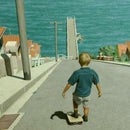Introduction: 40K Bolter Prop
Ok the plan here was to make a 40k blaster prop from wood, plastic, foam, whatever was needed to put it together.
This project was started like 4+ years ago. I would start it, get busy with something else and it would end up back in the attic. Twice I brought the project out to work on it until it was finished and twice I didn't The 3rd time I swore I would finish it, I finally did.
When I started I didn't have the tools to make it. When I started I didn't have a table saw. So I went out and got one. I did a drawing in Rhino 3d (that drawing is long gone, two laptops back) and once I understood how big I wanted it to be, I mostly finished the drawing - enough to start. Some years later. I picked up a 40w eBay laser cutter and realized that I could continue working on it because with out it, making things like the flames or the hand guard wasn't practical (i.e. me being lazy) so work continued.
I didn't paint the the prop. I put an ad out on craigslist and found someone to help me out. I was determined to finish the thing and knew if I tried to paint it, it would of ruined all of my work.
This is a short instructable. I've included a few pictures I took over the years while putting it together
Supplies
Materials
pine board. fiber board, foam Halloween skull, primer, spot putty, bondo, nails, staples. Plexiglas, pvc pipe. all sorts of arts and crafts items.
Tools
Table saw, jig saw, belt sander, 40w eBay laser cutter, CorrelDraw (for driving the laser cutter). Misc hand tools.
Step 1: Design/Initial Work
So I got a hold of every bolter picture I could find. Then I decided how big I wanted the thing to be and worked on a basis design using Rhino 3D. When you have a table saw everything you are gonna make is basically a box. One reason I decided to build a bolter - not many curves to it.
Cut as much of the body and cover on the table saw as I could. cut the rest with a hack saw or hand held jig saw.
For the grip -that was the only curvy part and I just filed and rasped a block of wood together to make the handle. Trial and error and bondo. For the brass pieces in the handle and pommel. I made separate pieces and fit them into the grip. More bondo and sanding. Barrel was easy - PVC tubing and a piece of wood - epoxy and kinda done!
I made the site rail, site, misc pieces on the bolter the same way. Then the project got parked for a year. I wasn't up to trying to make the handle, skull or flames using the same method.
Step 2: Laser Cutter - Work Continues
During that time I picked up a 40w eBay laser cutter for another project (see my control panel instructable). Once that was done and the trauma of that project was over, I realized I could do a lot of the part using the laser cutter - bolt latch, flames, mag release, trim around the bolter cover AND the front grip with it. So I was back motivated again to continue.
I decided to push through and finish off the thing. For the rounds I used PVC tubing, two tone painted them and glued them into the magazine. Then I glued the mag into the frame.
The front grip was made from stacking 3/16 wood cut from the laser cutter and stacked, until it became a complete front grip.
The trim around the thing was made from 6-7 pieces each individually cut. That was for both sides.
I figured out in CorrelDraw how to import an image and turn it into a object. Found some hot rod flames, imported them, text cut them with some thin craft foam, then cut the real ones out of 1/8" Plexiglas sheet. (I melted the tips on the first couple - trial and error).
Mistake made at this point - gluing the skull, flames hand guard and misc other pieces to the main gun. This was to cause the person that painted it a LOT LOT LOT of trouble.
Step 3: Painting
Well, I knew if I tried to paint it I would ruin it. And I knew I wasn't motivated to even spend the time to do that. Or motivated to learn how to paint it, so I out-sourced. I posted an ad on Craigslist for a painter.
This was a first time for me. I would always take on all parts of a project, regardless of the outcome.
Step 4: Finished
Finished. Now I have to convince my wife its fine art and should be hanging on the wall in the living room and not the garage.













